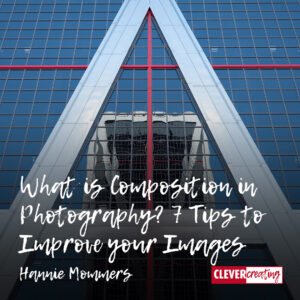
During my education at two art academies in the Netherlands, I was trained to look at the composition of paintings and sculptures. That was a big advantage for me when I started taking pictures.
Painters often had a conception of composition that depended on their time. The Renaissance had a balanced, calm structure of the works. In the Baroque, the dynamic composition was usually applied.
What is composition in photography? The usual rule of thumb is the rule of thirds. It’s a great rule to start with, but in this article, I will explain some other possibilities for composition you can use.
Some of the links are affiliate links. As an affiliate associate, I earn a small commission when you purchase any of the products offered through the shared links at no extra cost to you. This helps me to maintain this website and I thank you for supporting me.
Table of Contents
What is composition in photography?
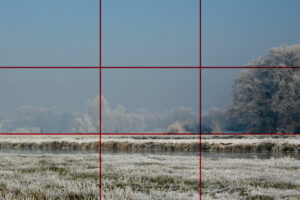
There is little difference between the composition of a painting or a photograph. Although you can more easily adjust the objects in a painting by omitting something or putting it in a different place.
If you want to take a photo and something is not in the spot you want it to be, you will have to move yourself to a different position. Though you could move loose objects. And if there are people in the photo, you can direct them to stand in a specific place.
Composition is the conscious arrangement of elements, an attempt to create order out of chaos. Not only shapes are important in a composition, but also colours and lines.
No matter what kind of composition you are choosing for your picture, the main point of interest should be your focus. What subject are you taking a photo of and is there enough attention for it?
Related: How to Stay Inspired in Photography? Of these 7 Tips, I Particularly Like #6

Rule of thirds
The most famous rule in photography is the rule of thirds. Most cameras, including those of a smartphone, have a three-part grid in the viewfinder that serves as an aid.
The image is (invisibly) divided into three equal parts both horizontally and vertically. Important areas are the four intersections on which you can place the most important part of the image. In my self-portrait, one of the eyes is on such a crossing point.
Also, the 4 lines that make the division, can be useful in positioning the elements of your composition. Have a look at the landscape pictures to see what I mean. You can use either one of the vertical or horizontal lines.

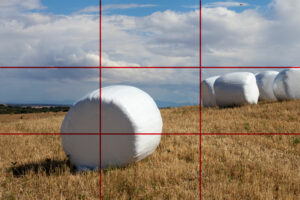
Symmetry
The easiest way to make a composition is symmetry. I always call it the Catholic way because the Holy Mass consists of symmetrical gestures and objects placed on either side of the altar. Pictures composed this way are peaceful and will have a quiet mood.
A clear example is the photo of the tiles. Buildings also lend themselves very well to a symmetrical photo. Symmetry has the disadvantage that it quickly becomes boring.
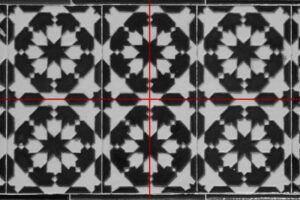
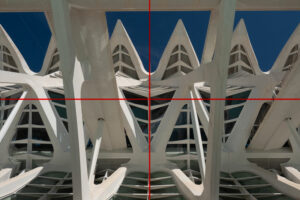
Dynamic composition
Although I take a lot of symmetrical pictures, I think it is very interesting to look for a dynamic contrast. Possible contrasts are:
- Full of details/Empty space;
- Lots of colour/Monochrome;
- Dark/light.
In the picture of a boat, you can see I have looked for a symmetrical composition while using a dynamic contrast between the ‘occupied’ left and the ‘empty’ right side. Buildings can also be photographed in a dynamic composition.

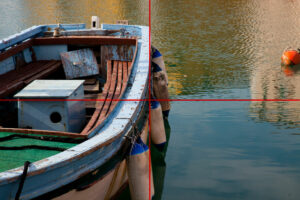
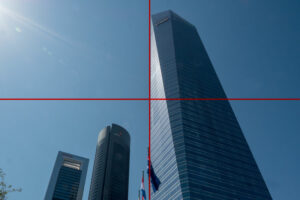
Related: 7 Ways to Use Colour in Photography Creatively and Differently
Diagonal composition
Usually a diagonal will make a composition dynamic, depending on the subject of course. If that subject is a frozen puddle, the image will be very peaceful.
Landscapes are often great for a diagonal composition. Or objects can be positioned in a diagonal way.

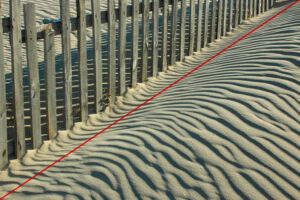
Related: Photo Festival Rencontres 2023 in Arles from a Viewer’s Perspective
Vanishing point
A vanishing point will suck the viewer into the image and creates an enormous suggestion of depth. The purest way is to position the vanishing point right in the middle, but as you can imagine, this point can also be on the thirds-line or anywhere else.
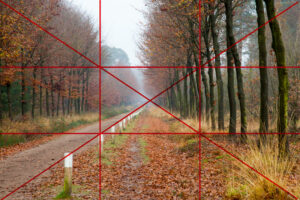
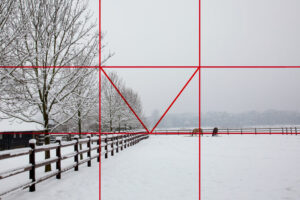
Look through
A picture gets extra depth when you make it through something else. Branches or leaves hanging in the front while photographing a landscape. A window, the bows of a bridge, or a tunnel are another way to make a kind of frame for your image.
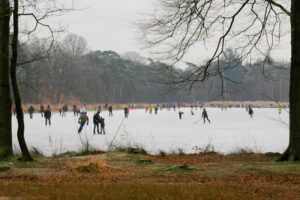
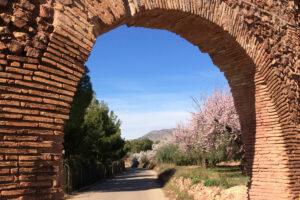
No grid at all
Not every picture needs to follow one of the former composition rules. A lot of my pictures are textures of all kinds. They don’t have grids. Unless you desperately want to see a grid, in that case, you may notice the diagonal from top-left to bottom-right in the yellow picture with the light playing on the fruits. 🙂

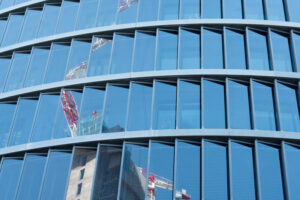
Knowing the rules means you can break them
I am a strong supporter of knowing the rules, but that does not mean that you should follow the rules no matter what. Once you know them and have mastered them, break them. (Uhm… concerning the composition, I mean).
The funny thing in my first example is, that I deliberately broke the rule of thirds in this landscape and put the horizon extremely low, but when I drew the lines in order to show you, I discovered that the rule of thirds was in place after all!
Likewise in the picture of the blossom: the sun turned out to be in the cross line of the rule of thirds.
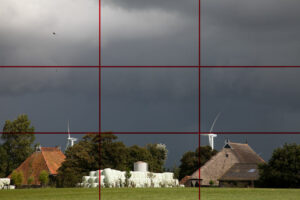


A lot of cameras have a display at the back or in the viewfinder with the grid shown. So will your smartphone. If you don’t see it, have a look at the settings.
The grid helps you to follow the rules or to disregard them. One way or the other, I am sure that if you take your pictures with these rules in mind, they will come out better than before.
Good luck and please let me know if you have any questions. Put them in the comment box below and I will gladly answer them.


Although I do not take a lot of photos, I like it when the composition is interesting. Let’s say, when the photo triggers the viewer to take a closer look.
From my limited experience I understand that it requires a lot of discipline to trigger the viewer. For example, I always have to force myself to genuinely look through the lens and ask myself at that very specific moment: ‘What do I see? Is it really interesting? What could trigger the viewer?’
This takes a lot of concentration and I get too easily distracted. For me this means that applying your suggestions, I need even more discipline. And experience of course. Perhaps its best to do this, to just make more photos.
This is made much more easy because I always have my mobile phone with me. I also applied the grid on the camera. Which helps me to focus better, I hope.
Hi Richard, I am sure the grid will help you a lot. It is also a visual reminder to take notice of the composition.
However, I wouldn’t force myself into too much discipline, if I were you. Taking lots of pictures and having fun while doing that is much more important. What I would recommend is to look closely afterwards when you are rearranging or editing your pictures. Because that is a moment you are at ease and can take a closer look at what exactly it is you did. The experience will come in due time then. 🙂
Have fun and thanks for your comment.
Geometry is an innate part of photography and this proves it. I’m with you with the going with the flow approach, I tend to ignore what I know quite a lot if my senses tell me I could get a better shot.
If you have a mathematical mind like me and probably like you, then you can indeed trust your intuition at some point. Just as I eventually found out that compositions that I had made without thinking about rules were ultimately exactly according to the rules. 🙂
Thanks for sharing your thoughts, Rylee, and have fun.
I have to admit, I thought learning the basics would be an easier task. I’m not the creative or artistic type which makes it harder for me to see art all around me. But composition makes it easier to understand what I should be looking for and how to frame a certain shot. Thanks!
Unfortunately, every new skill comes with a learning curve, Lilly. On the other hand, it is very satisfying if you succeed at it. And I am really glad my explanation about composition set you on your way to mastering photography.
Everybody is creative and artistic in her or his own way, you can be sure of that. Practice makes perfect, so if you keep on making lots of pictures, you will surely improve yourself!
Thanks for your comment and good luck.
Great information here. I know the rules but usually break them; it’s my photo and I do what I want! Your photo of the day is indeed inspiring.
And yep, I have more questions again. I hope you don’t find them annoying and take them as a compliment to your ability to create, teach, and promote creativity.
1.) I noticed on Squidoo you were able to put the copyright symbol by your photos. Did you do that with HTML? If not, how would one go about copyrighting an image?
2.) I started writing on the Internet and don’t know much about any other blog sites. I am not very technologically advanced but I love the art of figuring out How Something Works. Would this site be a good one for blogging, my niche being my Photo Diary idea? It would be handy to have my own place to link pictures back to instead of relying on photobucket and the likes.
I have the ability and the drive to use my skills of Creating.
Thank you so much for what you have shared with the world.
Yours Truly,
Jes
Hi Jes,
1. Do you mean the copyrightsymbol © or do you mean my watermark?
2. I made this website in WordPress. That’s not very complicated to work with. You can either start on wordpress.com (the address will be something like bigreddomino.wordpress.com) or you can install a wordpress-instllation on an own domain (the address will be something like bigreddomino.com)
I hope this helps.
Take care,
Hannie